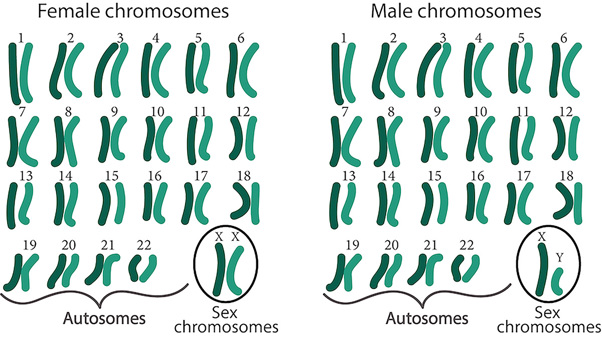
Is a transgender woman still genetically male after surgery?
March 18, 2020

- Related Topics:
- Gender identity,
- Genetic sex,
- LGBTQ+
A curious adult from New Jersey asks:
“Genetically, is a transgender woman still a male regardless if she has had sex reassignment surgery?”
What a thought-provoking question! First, it’s important to understand that biological sex and gender identity are not the same.
Biological sex refers to the physical features of a human body (or anatomy).
Gender identity refers to one’s internal sense of being. That may align more toward being a male, female, or anywhere in between. Some people who identify as nonbinary may not have an internal sense of being a male or female at all!
Sex reassignment surgery involves changing a person’s anatomy. Whether a person identifies as a male or female shouldn’t change after surgery. And it doesn’t change their genetics either!
Let’s take a deeper dive.
Genetics overall cannot be changed (so far, at least)
Each person is born with a set of genetic instructions wound up into packages called chromosomes. The instructions can help determine things like hair color or eye color.
There are also genetic instructions that can lead to sex characteristics. Sex chromosomes, in particular, determine whether someone will have female or male body parts.
As you can see in the image below, these are chromosomes found in a typical person. We each have 23 pairs. The last pair are known as the sex chromosomes. Usually a person will have either an XX or XY pair of sex chromosomes.

Typically, someone with two X chromosomes will have female body parts. An individual with one X and one Y sex chromosome will usually have male body parts. It is the presence of this Y chromosome that determines a person’s biological sex.
Whatever set of chromosomes a person has when they are born cannot be changed. This is because chromosomes are in all the cells that make up our bodies.
To change a person’s chromosomes would mean changing trillions of cells! There aren’t any technologies (and probably won’t be in the future) that can change a chromosome in all of a person’s cells.
Chromosomes do not define gender
Sometimes people do not identify with the biological sex they are assigned at birth. In short, this is what it means to be transgender. For example, someone can have XX chromosomes and not identify as female. Or they can have XY chromosomes and not identify as male.
There are also some medical conditions that make identifying as male or female not so simple. For example, some people with XY chromosomes may have a condition where their bodies cannot react to male hormones. In turn, they look, act, and feel like women. An example of such a condition is Androgen Insensitivity Syndrome.1
In other cases, people with XX chromosomes may have a condition that exposed them to high levels of male hormones before birth, giving them male body parts. An example of such a condition is called Congenital Adrenal Hyperplasia.2 This can lead to the individuals looking and feeling more like men.
Some individuals may also be born with an extra X chromosomes such as in Klinefelter Syndrome3 or with an extra Y chromosome as in 47,XYY Syndrome.4
It’s important to know that having one of these conditions does not mean someone is transgender or more likely to be transgender. These are just examples of how gender is more than just X’s and Y’s!
Whichever gender someone identifies with (or not) is based on their internal sense of being, not chromosomes. Chromosomes can only say what a person is born with, not how they see themselves.
Anatomy does not define gender
Most people are assigned a biological sex at birth based on their body parts, not on their chromosomes. But again, just because someone is born with male body parts does not mean they identify as being male.
Some transgender people choose to have sex reassignment surgery to better match the sex they identify. However, some do not. Regardless if a person chooses to undergo sex reassignment surgery or not, it’s important to be respectful of how people may or may not identify!
All in all, if a transgender woman was born with a set of XY sex chromosomes, she will still have XY chromosomes after sex reassignment surgery. Having XY chromosomes does not mean that a person is male. It just means they most likely had male body parts at birth.

Author: Tiffany Nguyen
When this answer was published in 2020, Tiffany was a student in the Stanford MS Program in Human Genetics and Genetic Counseling. She wrote this answer while participating in the Stanford at The Tech program.
 Skip Navigation
Skip Navigation
